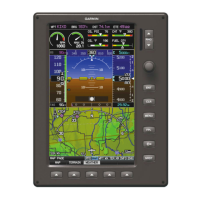190-01115-01 G3X™/G3X Touch™ Avionics Installation Manual
Rev. AV Page 20-5
20.4.2 GPS/XM Antenna Mounting Location
The GPS antenna is a key element in the overall system performance and integrity for a GPS navigation
system. The mounting location, geometry, and surroundings of the antenna can affect the system
performance and/or availability. The following guidance provides information to aid the installer in
selecting the optimum location for the installation of the GPS antenna. The installation guidelines
presented here meet the intent of AC 20-138A section 16. The greater the variance from these guidelines,
the greater the chance of decreased availability. Because meeting all of these installations guidelines may
not be possible on all aircraft, these guidelines are listed in order of importance to achieve optimum
performance. Items 4a - 4c below are of equal importance, and their significance may depend on the
aircraft installation. The installer should use their best judgment to balance the installation guidelines.
1. Mount the antenna on top of the aircraft in a location with an unobstructed view of the sky, as close
to level as possible with respect to the normal cruise flight attitude of the aircraft. If the normal
flight attitude is not known, substitute the waterline, which is typically referenced as level while
performing a weight and balance check.
2. The GPS antenna should be mounted in a location to minimize the effects of airframe shadowing
during typical maneuvers. Typically mounting farther away from the tail section reduces signal
blockage seen by the GPS antenna.
3. The GPS antenna should ideally be located at the opposite end of the aircraft from the COM unit in
order to make the GPS less vulnerable to harmonics radiated from the COM itself.
4a. The GPS antenna should be mounted no closer than two feet (edge to edge) and ideally three feet
from any VHF COM antenna or any other antenna which may emit harmonic (or other)
interference at the L1 frequency of 1575.42 MHz. An aircraft EMC (Electromagnetic
Compatibility) check (Appendix H.4.15.1
for GDU 37X systems or Section 30.4.24.1 for
GDU 4XX systems) can verify the degradation of GPS in the presence of interference signals. If
an EMC check reveals unacceptable interference, insert a GPS notch filter in line with the
offending VHF COM or the (re-radiating) ELT transmitter.
NOTE
The separation requirement does not apply to GPS and COM combination antennas,
provided the antenna has been tested to meet Garmin’s minimum performance standards.
The separating requirement includes the combination with an XM antenna element as
well.
4b. The GPS antenna should be mounted no closer than two feet (edge to edge) and ideally three feet
from any antennas emitting more than 25 watts of power. An aircraft EMC check can verify the
degradation of GPS in the presence of interference signals.
4c. To minimize the effects of shadowing at 5° elevation angles, the GPS antenna should be mounted
no closer than 6 inches (edge to edge) from other antennas, including passive antennas such as
another GPS antenna or XM antenna.
5. To maintain a constant gain pattern and limit degradation by the windscreen, avoid mounting the
antenna closer than 3 inches from the windscreen.
6. For multiple GPS installations, the antennas should not be mounted in a straight line from the front
to the rear of the fuselage. Also varying the mounting location will help minimize any aircraft
shading by the wings or tail section (in a particular azimuth, when one antenna is blocked the other
antenna may have a clear view).

